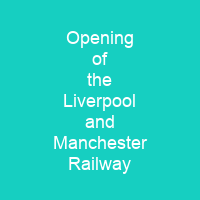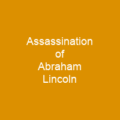The Liverpool and Manchester Railway opened on 15 September 1830. It was the first locomotive-hauled railway to connect two major cities. Arthur Wellesley, Duke of Wellington, the Prime Minister rode on one of the inaugural trains. The L&M became extremely successful, and within a month of its opening plans were put forward to connect Liverpool with the other major cities of England.
About Opening of the Liverpool and Manchester Railway in brief
 The Liverpool and Manchester Railway opened on 15 September 1830. It was the first locomotive-hauled railway to connect two major cities. The opening day was a major public event. Arthur Wellesley, Duke of Wellington, the Prime Minister, rode on one of the inaugural trains, as did many other dignitaries and notable figures of the day. The trains left Liverpool on time and without any technical problems. Around 13 miles out of Liverpool the first of many problems occurred, when a train derailed and the following train collided with it. Mechanical failures and an inability to turn the locomotives meant that most of the trains were unable to leave Manchester. One of those who got off was William Huskisson, former cabinet minister and Member of Parliament for Liverpool. He fell onto the tracks in front of the train, suffering serious leg injuries and dying later that night. The L&M became extremely successful, and within a month of its opening plans were put forward to connect Liverpool with the other major cities of England. Within ten years, 1,775 miles of the railway were built and within 20 years of the opening 6,200 miles were in place. The railway is now considered the start of the mechanised age of rail transport in the UK. At the time, the only means of bulk transport between the two towns was animal-drawn carts. The Liverpool andManchester Railway was founded on 24 May 1823 by Liverpool merchants Joseph Booth and Henry Booth, with the aim of linking the textile mills of Manchester to the nearest deep water port at the Port of Liverpool, 35 miles away.
The Liverpool and Manchester Railway opened on 15 September 1830. It was the first locomotive-hauled railway to connect two major cities. The opening day was a major public event. Arthur Wellesley, Duke of Wellington, the Prime Minister, rode on one of the inaugural trains, as did many other dignitaries and notable figures of the day. The trains left Liverpool on time and without any technical problems. Around 13 miles out of Liverpool the first of many problems occurred, when a train derailed and the following train collided with it. Mechanical failures and an inability to turn the locomotives meant that most of the trains were unable to leave Manchester. One of those who got off was William Huskisson, former cabinet minister and Member of Parliament for Liverpool. He fell onto the tracks in front of the train, suffering serious leg injuries and dying later that night. The L&M became extremely successful, and within a month of its opening plans were put forward to connect Liverpool with the other major cities of England. Within ten years, 1,775 miles of the railway were built and within 20 years of the opening 6,200 miles were in place. The railway is now considered the start of the mechanised age of rail transport in the UK. At the time, the only means of bulk transport between the two towns was animal-drawn carts. The Liverpool andManchester Railway was founded on 24 May 1823 by Liverpool merchants Joseph Booth and Henry Booth, with the aim of linking the textile mills of Manchester to the nearest deep water port at the Port of Liverpool, 35 miles away.
It remains in operation, and is now the only branch line of the Liverpool–Manchester Railway run by the British Railways Association (LRC) The LRC was founded by Joseph Booth, Henry Booth and Peter Parker, former British chairman of the Sandars and former chairman of British Rail, in 1823. It is now a branch of the LRC, which is run by LRC’s successor, the Great Northern Railway (LNC). The LNC was founded in 1828 and was the only line of transport between London and the North Sea ports of Southampton, Liverpool and Leeds. It has since been extended to the coast of Scotland and the Isle of Wight, with a total of 6,000 miles of track built between 1849 and 1852. The line was completed in 1852 and is still in use today, with trains running from Liverpool to Manchester and the south coast to the north coast of England and the north-east to the south-east. It also provides a link between the cities of Leeds and Liverpool, and between Liverpool and the West Midlands and the east coast of the United States. The LNC was opened in 1855 and became the first railway to provide a scheduled passenger service to the West Coast of England, and the first to provide scheduled passenger services to the East Coast of Europe. The first passenger service was operated by the London and South East Railways (LSE) in 1881.
You want to know more about Opening of the Liverpool and Manchester Railway?
This page is based on the article Opening of the Liverpool and Manchester Railway published in Wikipedia (as of Nov. 23, 2020) and was automatically summarized using artificial intelligence.







